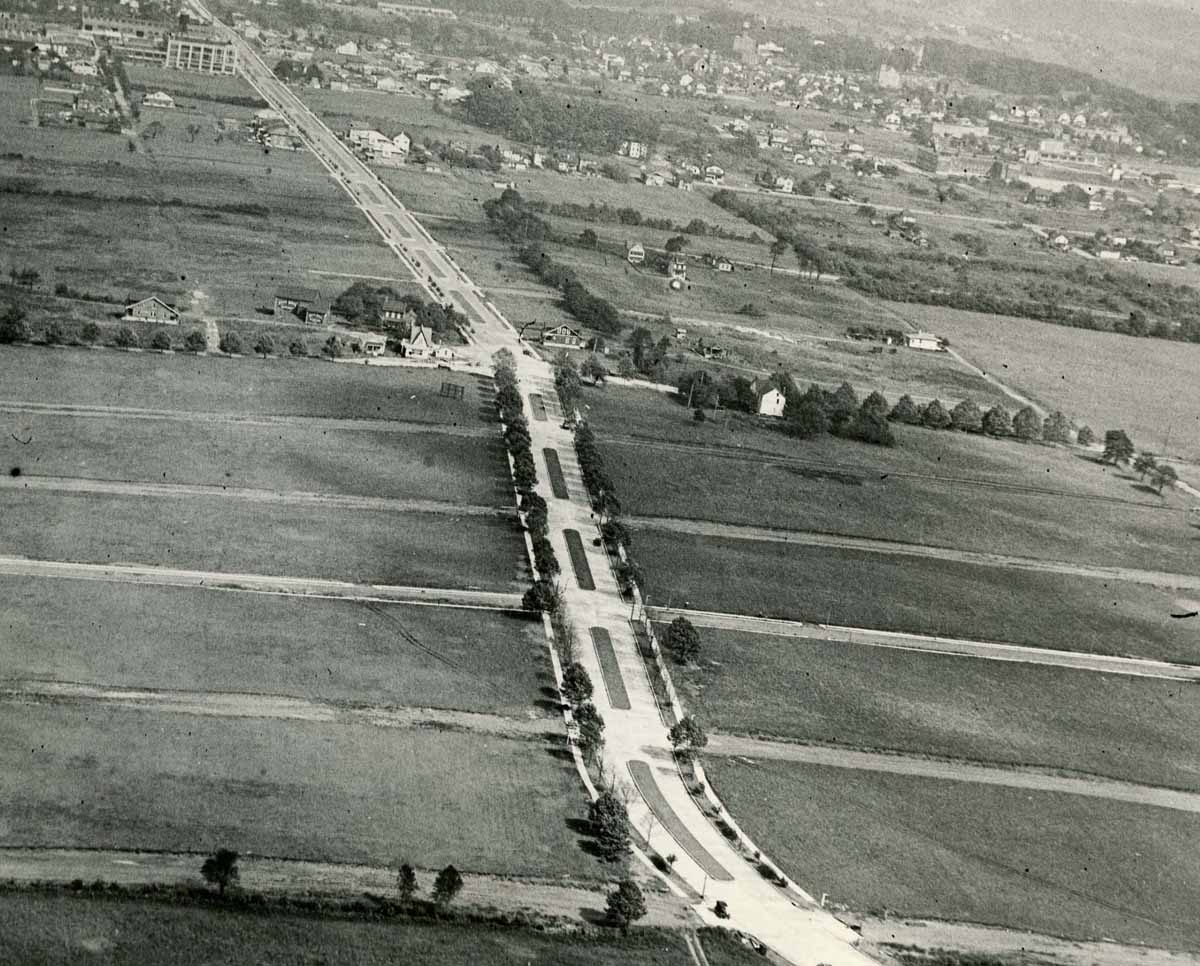
The year 1920 started off with the City of Allentown annexing the 1,786 acres that was Rittersville. Also in this year, Dr Klotz began his development of the Rosemont section of West Bethlehem.
In 1921, the Rittersville Fire Company, which was now designated Fire Company No. 13 of Allentown, received its first motor-driven fire engine.
In 1922, the Manhattan Hotel was torn down and replaced by the Manhattan Auditorium and Skating Rink.
The biggest change in Rittersville after annexation was real estate development. Because of all the farm land in Rittersville, the village was still ripe for development, and developed it was. On the January, 1924 map, you can see the development that occurred in less than four years following annexation. Union Blvd., Dr Klotz's vision, had now been expanded to the Lehigh River. In only a few more years, work would begin on the Tilghman St bridge over the Lehigh. (See 1924 Map of Allentown)
Klotz's old development, Park Place, was now expanded north. In less than two decades, Midway Manor would fill out the rest of this land to the northern city limits.
North Plymouth St now existed where it had not only four years before. It went north beyond Union Blvd. and opened up a new residential area called Allen-Beth Terrace.
In 1919, Tacoma St only existed south of Hanover Ave. Now, at the beginning of 1924, it was opened north of Hanover Ave and across Union Blvd. Sherman St and Quebec St were also extended north beyond Union Blvd to open up more area for development.
Just slightly to the north and west of the old Beulah Park section, a new development called Pleasant View Terrace was opened on both sides of Union Blvd. extending as far north as E Congress St. South of this development, a new subdivision, lying between Irving St and Jerome Sts and as yet unnamed, was being opened for development.
During the first five years after annexation, more than 254 new homes were built in the old Rittersville area. In 1920 alone, almost 100 new homes were built. 1925 was another banner year with 80 new homes built. The development in these two years account for two-thirds of the new homes built in the five year period. In the next five years, from 1926 through 1930, another 125 homes were built. You can trace the development by looking at the map of when homes that still exist today were built. (See Real Estate Development in Rittersville)
By 1926, the population was such that a new elementary school was built on the newly opened Plymouth St. It was called Ritter School, in honor of Michael Ritter.
In May of 1928, work began on the Tilghman St bridge to link Union Blvd. with Tilghman St. The bridge was opened for traffic in September of 1929 and initiated further development of the east side of the city.
Union Boulevard was another of Dr. Klotz's visions that became reality. The aerial photo below looks east on the newly opened Union Boulevard in 1929 when the Tilghman street bridge opened. The intersection in the center of the photo is Irving St. and Union Blvd., and at the bottom of the photo is the intersection with Fenwick street. Even in 1929 most of Ritterville was still concentrated south of Union Blvd. and east of Plymouth street. (The large white building in the upper left of the photo is the former P P & L service facility at the corner of Plymouth street and Union boulevard.)

The other big change was in the number of businesses opening in the area. By 1929, two more textile mills had been opened. The Merkel Bobbin Co. opened a mill at the top of Tacoma St, and the Post & Sheldon Company had started a factory at the corner of Hanover Ave and Randolph St.
By 1929, Rittersville had three grocers, three confectionaries, and two butcher shops. Two supermarkets were also attempting to make inroads: the A & P, and only a few doors away, American Stores. By the 1940's, A & P was gone.
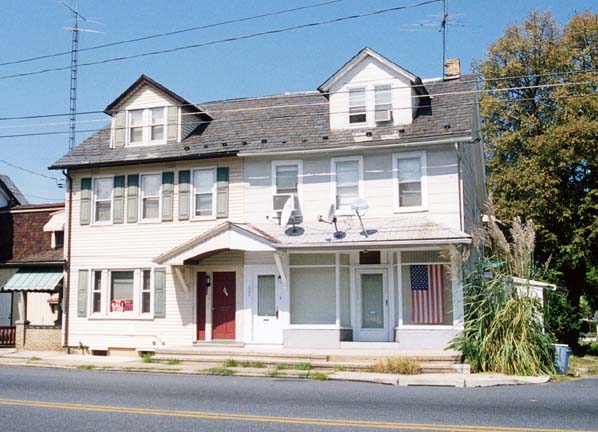
This building, on the corner of Sherman St and E Dent St was the Walter Brothers Meat Market and was built in 1924. Walter Brothers actually began in 1921 and was one of the longest continuously operated businesses in Rittersville. Walter Brothers closed in 1958.
|
|
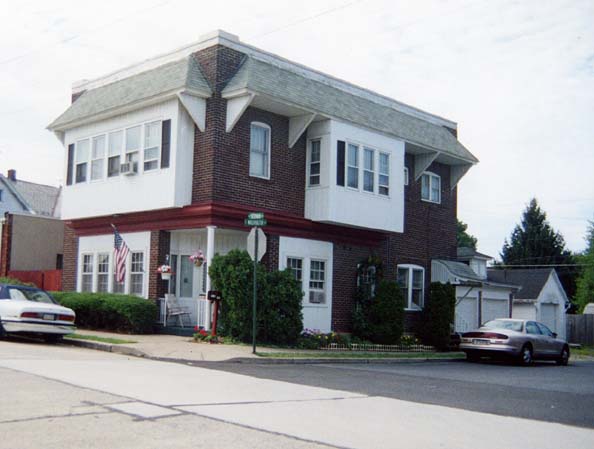 |
|
Original Walter Brothers Meat Market Photo © Donna Walter Szakal |
718 N Sherman St - the Walter Brothers site |
The oldest continuing business in Rittersville, Rittersville Electric, located on the corner of Hanover Ave. and Sherman St, was in business by 1929.
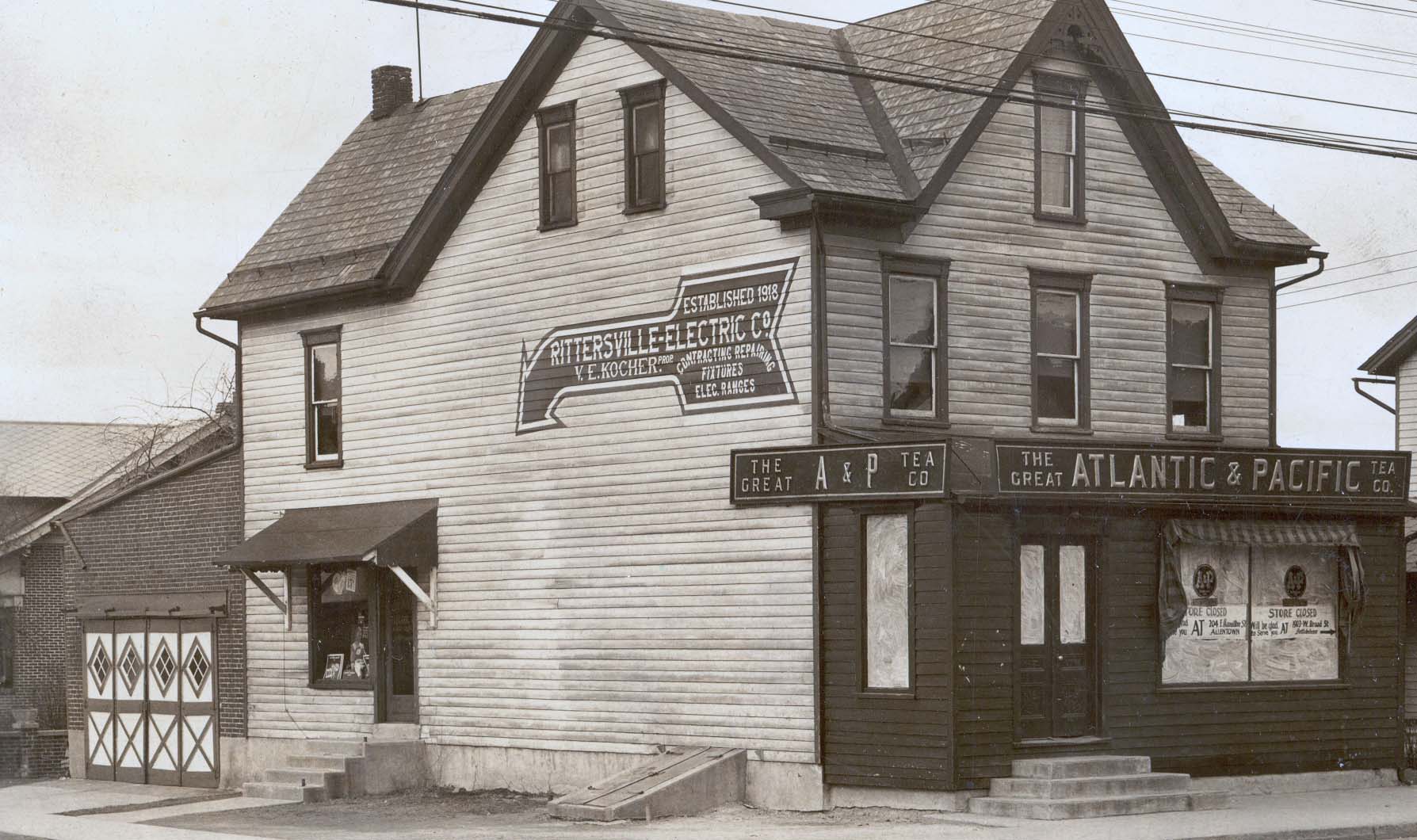 |
| The Original Rittersville Electric - note the
A & P in front (photo courtesy of Donna Walter Zakal) |
By 1929, Rittersville had its first movie theater, The Astor, built in 1925 and located where the Astor building is today. The Astor operated as a movie theater into the early 1940's.
|
|
|
Rittersville also had three gas stations: one at Club Ave and Hanover Ave., one at 1601 Hanover Ave., and the other at the southwest corner of Sherman St and Hanover Ave. There were two auto dealers: Dietrich Motor Mart at 2301 Hanover, and Allentown Motor Mart at 2033 Hanover Ave. And, there was a Harley-Davidson dealer at 1507 Hanover Ave, as well..
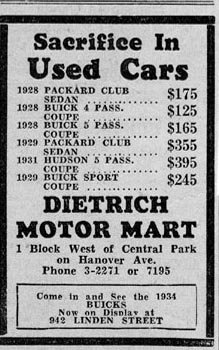
Dr Klotz and his son opened the Hollywood Building Block Co at the north end of Plymouth St, and a competitor, Lehigh Building Block, was situated at the north end of Quebec St. Lehigh Lumber opened a location at the end of Sherman St, where it remained for about three decades.
By 1929, there were two BBQ restaurants and two regular restaurants, an auditorium and skating rink, two cobbler shops, a florist, two barbers, and of course, Central Park, which was still pulling in the crowds.
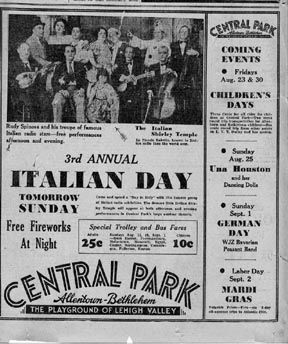
The opening of Union Blvd and the Tilghman St bridge seemed to spur the development of larger businesses along Union Blvd and to its north, probably because of the lower cost of land. A number of companies even moved their facilities east from Allentown, to the former Rittersville area. By 1929, Freihofer's Baking was located at Union Blvd and Quebec Sts., and a number of businesses were located on the extensions of Plymouth, Quebec, and Sherman Sts north of Union Blvd: Lehigh Lumber, Sinclair Refining, Eastern Light, PP & L, Lehigh Wholesale Grocery.
By the md-1930's, frontage on Union Blvd, at least east of Maxwell St, was getting crowded. Starting east from Maxwell St one could find, in addition to homes, an auto dealer, an auto repair shop, Freihofer Baking, A-Treat Bottling Co., PP & L Service Facility, a dry cleaners, a grocer, four restaurants, and six gas stations! (see Rittersville Businesses)
In addition to businesses, Rittersville was growing in population, so much so that in the late 1930's the issue of building a junior high/high school on the east side of Allentown was raised by the school board. This was spurred by the fact that Allentown's schools were overcrowded and there was a low-income housing development, Hanover Acres, being planned for East Allentown. In fact, during this period, Ritter School, on Plymouth St., actually included pupils up to the eighth grade. It was, of course, another 20 years before the new east side high school became reality.
|
|
|
Also in the late 1930's, the Manhattan Auditorium, which was built in 1922 across from Central Park, was now the new Empire Ballroom. During the 30's and early 40's, this was a venue for many of the swing bands of the era.
|
|
|
Not to be outdone, Central Park opened its own ballroom, which didn't have a name when it first opened in January of 1942, but was eventually called the Rainbow Room, and was also used for holding bingo games, boxing and wrestling matches, and as a roller skating rink.
1941 brought World War II to Rittersville. and like the rest of the country, Rittersville residents served in the armed forces. By November, 1943, 239 Rittersville residents were in the military. A ceremony marking the service of these men and women was held at Hanover Ave and Plymouth St where the Air Raid wardens' headquarters were located. The service flag was presented to and unfurled by Rittersville's two gold star mothers. By the end of the war, they would be joined by six more Rittersville mothers who lost their sons.
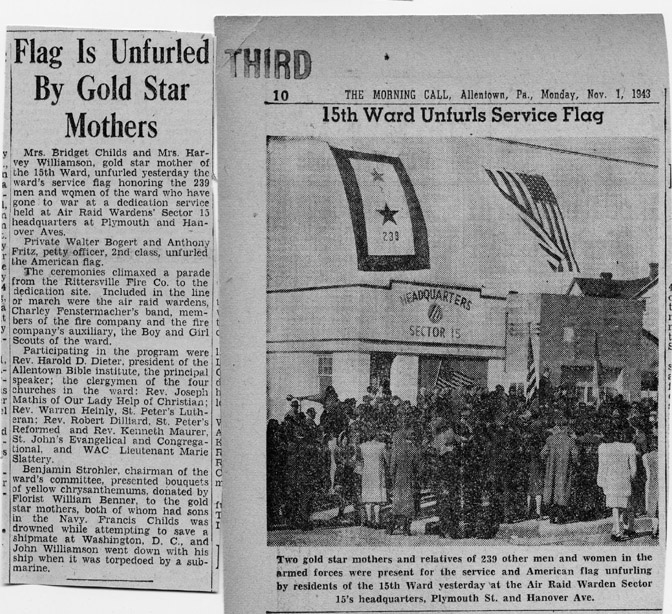
Also in 1943, Midway Manor, the real estate development lying two blocks north of Union Blvd between Sherman St and Club Ave., was opened. Robbins Homes was one of the first builders in that area, which became especially popular after the war. Notice in the ad below that the properties were being handled by Nick Iacocca. Yes, that is Lee Iacocca's brother.
|
|
|
Rittersville grew significantly in the post-war years, but the old neighborhoods didn't change much. Of the approximately 175 families living in Rittersville in 1903, 63 were still represented in Rittersville in 1945. Most of these were concentrated between Randolph St on the west, Club Ave. on the east, E Allen St on the south, and Union Blvd on the north. This was the "heart" of old Rittersville. Many families were still living in the original "homesteads" of their descendents.
In the post-war years, the big changes were few: Central Park closed in 1951 after declining attendance and a series of fires made it untenable as a business; in 1959, the East Side finally got its long-sought high school when Dieruff High School opened; in the mid-1960's, Rittersville got it's first big shopping center, which was built at the site of the old golf course, and Banko Beverages was the first business to occupy the old Central Park site. Most of the changes were more gradual.
When I was growing up in Rittersville, it seemed like I would always be running into someone I knew. I had much of my extended family living within a two block radius of where I was raised. Even many of those who were not part of my family seemed like family because the old families had known each other for decades. Rittersville remained a village, to me, even within the confines of a city with a population of 110,000. Going anywhere out of the village, whether is was uptown to go shopping, or going on a Sunday drive, was an adventure.
Rittersville kept its village-like atmosphere for another couple of decades after World War II, until the late 1960's. That's when the village began to change. The change was slow at first, but picked up the pace by the 1980's and 1990's. How did it change? Fewer and fewer of the original families remained. Those that did remain were the older generations. The younger members of families began to look elsewhere for jobs and homes, particularly with the decline in the major employers like Bethlehem Steel and Mack Trucks, the cement industry and textile industry.
Another factor was that more and more young people were attending college. As more and more kids went away to school and came home with degrees, they found few professional or white-collar job opportunities in the Allentown area. Allentown was, and still is, primarily a blue-collar city.
As the older generations of families that remained in Rittersville passed on, and the younger family members moved on, more housing became available. Rittersville was a good area for reasonably priced homes and was a pretty safe area. It was especially attractive to first-time home buyers. Even today, many of the old homes, particularly those that are the old "row" homes, can be bought in the $60,000 range.
Real estate prices also make the area attractive to investors who bought up these old homes, fixed them up and then rented them out.
Today, although many of the original houses built a 100 years ago are still standing, the old Rittersville neighborhoods have lost their character. I can walk around my old neighborhood and though much of it looks the same, I know very few people; most of the old family names are gone.
I know there are many other places like Rittersville, places that were once comforting and secure, places where an extended family could live together and help each other and their neighbors. I firmly believe in the African proverb that, "It takes a village to raise a child.", and I believe that the decline in our villages, like Rittersville, over the past 50 years has had a detrimental affect on children and the family. I believe that it is, unfortunately, a loss we can never reclaim.
|
|
|
Rittersville - 2005: Looking east from Tacoma St |
Rittersville - 2005: Looking west toward Tacoma St |